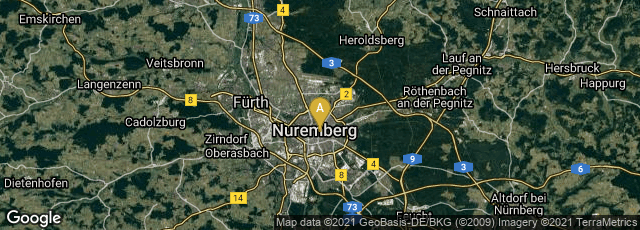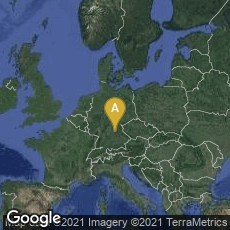

A: Mitte, Nürnberg, Bayern, Germany
Dutch physician, anatomist and comparative anatomist Volcher Coiter published Externarum et internarum principalium humani corporis partium tabulae . . . . in Nuremberg. It included 9 engravings (the first 4 on 2 leaves), all but 2 signed "V. C. D." for "Volcher Coiter delineavit," signifying that they were drawn by the author. The last 2 plates, of the human skeleton, were after the first and third skeleton figures in Vesalius's Fabrica. The woodcut historiated initials in the work were from the "Puttenalphabet" by Hans Weiditz, cut in Augsburg in 1531.
A student under Gabriele Falloppio, Bartoloemo Eustachi , and Ulisse Aldrovandi, Coiter made several important contributions to the study of human anatomy, and was the first to elevate comparative anatomy to the rank of an independent branch of biology. His Externarum et internarum principalium humani corporis partium tabulae published in 1572 is a collection of ten short works, among which are the first monograph on the ear (De auditus instrumento); the earliest study of the growth of the skeleton as a whole in the human fetus (Ossium tum humani foetus . . .); the first descriptions of the spinal ganglia and musculus corrugator supercilii (in Observationum anatomicarum chirurgicarumque miscellanea); and Coiter's epochal (although unillustrated) investigation of the development of the chick in ovo (De ovorum gallinaceorum generationis. . .), based upon observations made over twenty successive days. This last was the first published study of chick embryo development based upon direct observation since the three-period description (after three, ten and twenty days of incubation) given by Aristotle in his Historia animalium two thousand years before.
Coiter was one of the first physicians to draw the illustrations for his own publications, and to take credit for them in print. It is believed that Vesalius may have done some of the simpler illustrations for the Fabrica; however, none of the Fabrica images are signed, and questions concerning their authorship have led to centuries of speculation and debate. Coiter's illustrations of the adult skeleton and skull, after Vesalius, are superior in anatomical detail; and his sketches of fetal skeletons are original.
Cole, History of Comparative Anatomy, illustrates a copy of this work with the title-page dated 1572, but the majority of copies probably appeared in 1573, as most of the references cite the later date. Hook & Norman, The Haskell F. Norman Library of Science and Medicine (1991) no. 496.